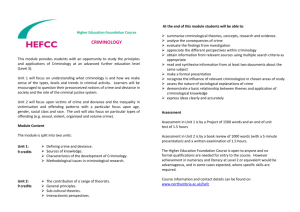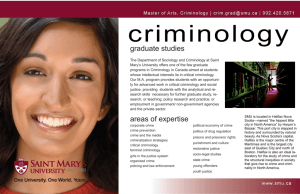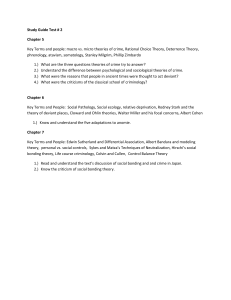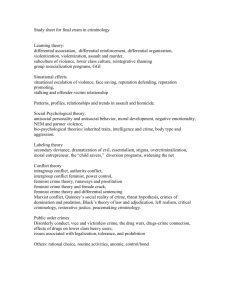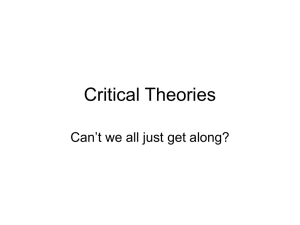Criminology
advertisement
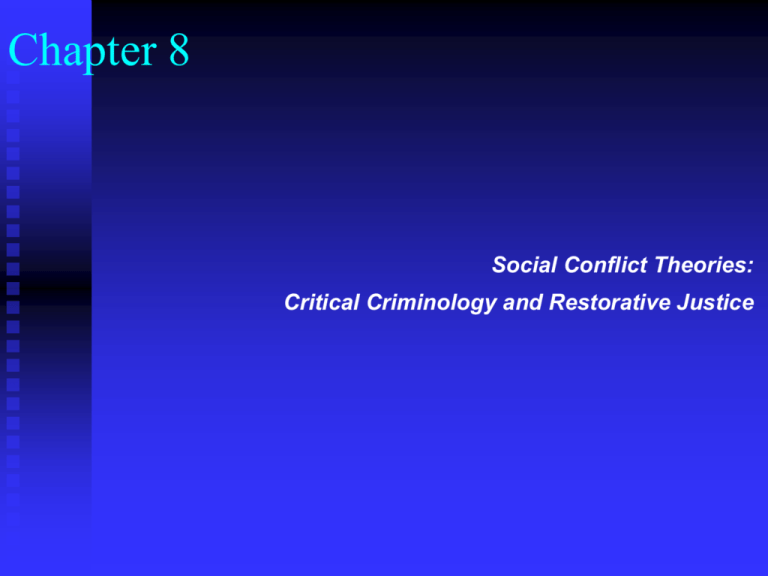
Chapter 8 Social Conflict Theories: Critical Criminology and Restorative Justice Social Conflict Theory Figure 8.1 The Branches of Social Conflict Theory Conflict: Good or Bad? • Bad when leads to destruction such as????? • Good when leads to positive social change????? Marxist Thought • Productive Forces and Productive Relations • Communist Manifesto focused attention on economic conditions of a capitalist system • Productive forces: • Include technology, energy sources, and material resources • Productive relations: • Exist among people producing goods and services Marxist Thought • Productive Forces and Productive Relations • • • • Bourgeoisie capitalists Proletariat working labor Lumpen proletariat poor Class denotes a position in relation to others Marxist Thought • Surplus Value • Laboring class produce goods that exceed wages in value • Excess value goes into the hands of capitalists • Marx suggested workers would emerge into a socialist state and own the means of production Marxist Thought Figure 8.3 Surplus Value Developing a Conflict Based Theory of Crime • The Contribution of Bonger • Upper class will commit if: • They sense an opportunity of make financial gain • Their lack of moral sense enables them to violate social rules • Crime and poverty are associated with unequal distribution of wealth Developing a Conflict Based Theory of Crime • The Contribution of Vold • Adapted conflict theory to criminology • Laws are created by politically oriented groups • Laws will be created to hamper and curb the interests of some opposition group • Criminal acts are a consequence of forces struggling to control society (conflict) Social Conflict Theory • Conflict theory tries to explain crime within economic & social contexts and to express connections between social class, crime, and social control • Relationship to crime began in the 1960s • Chambliss & Seidman suggests the justice system protects the rich and powerful Critical Criminology • Origins of Critical Conflict Theory • In 1980s left realism emerged which influenced peacemaking criminology • Critical conflict criminologists are concerned with the recent conservative agendas of cutting social programs and increased military spending Critical Criminology • Fundamentals of Critical Criminology • Crime is a function of the capitalist mode of production • The poor (proletariat) engage in street crimes, whereas the wealthy (bourgeoisie) are involved in acts not defined as crimes (racism, sexism, profiteering) • The rich are insulated from street crimes • The poor are controlled through incarceration, whereas the middle class is diverted from caring by the upper classes creating a public fear of the lower classes Critical Criminology • Globalization • Criminals are products of society and economic systems • Critical criminologists are wary of globalization and capitalization trends Critical Criminology • Research on Critical Criminology • Marxists suggest that traditional research is designed to unmask the weak and powerless • Critical research tends to be historical and analytical, not qualitative and empirical • Research involves both macro- and micro-level issues Contemporary Forms of Social Conflict Theory • Left Realism • Lea & Young • The poor are doubly abused by capitalists and by members of their own class • Relative Deprivation equals discontent discontent plus lack of political solution crime • Taylor • The world is currently in the midst of multiple crisis • Job creation, social inequality, social fear, political incompetence and failure, gender conflict, and family and parenting issues Contemporary Forms of Social Conflict Theory • Critical Feminist Theory • Critical feminists view gender inequality as stemming from the unequal power of men and women in a capitalist society • Patriarchal (male dominated) systems devalue the work of women • The exploitation of women produces far more surplus value for capitalists than it does for men Contemporary Forms of Social Conflict Theory • Patriarchy and Crime • Critical feminists link criminal behavior patterns to gender conflict created by economic and social struggles • Double marginality explains why women commit less crime than men • Crime is the vehicle for men to “do gender” Contemporary Forms of Social Conflict Theory • Exploitation and Criminality • Sexual victimization of females is a function of male socialization • Exploitation triggers the onset of female delinquency such as running away to avoid abuse • Some critics charge feminist scholars have ignored the interests of women of color and lesbians Contemporary Forms of Social Conflict Theory • Power Control Theory • Hagen • Crime and delinquency are a function of • 1) class position • 2) family functions • Fathers assume the role of breadwinners, while mothers have menial jobs and are expected to control the behavior of daughters • Dissatisfied girls seek “role exit behaviors” • Examples running away or suicide • In “egalitarian families” both the husband and wife share similar positions of power Contemporary Forms of Social Conflict Theory • Postmodern Theory • Semiotics refers to the use of language elements as signs or symbols beyond literal meaning • Deconstructionists analyze communication and language in legal codes to determine whether they contribute to institutionalized racism or sexism • Postmodernists contend value-laden language can promote inequalities Contemporary Forms of Social Conflict Theory • Peacemaking Criminology • Main purpose of criminology is to promote a peaceful society • Draws inspiration from religious and philosophical teachings • Punishment encourages criminality rather than deterring it (Tifft & Sullivan) • Try to find humanist solutions (mediation and conflict resolution) to crime and other social problems Public Policy Implications of Social Conflict Theory • The Concept of Restorative Justice • Contends that society needs to hold offenders accountable to put right their harms • Crime is an offense against human relationships • Victims and the community are central to justice processes • The first priority is to restore the community • The offender has a personal responsibility to victims and to the community for crimes committed • The offender will develop improved competency and understanding as a result of the restorative experience Public Policy Implications of Social Conflict Theory • Developing Restoration • The offender is asked to recognize and accept responsibility of their criminal actions • Commitment to material restitution and symbolic reparation (apology) • Determination of community support an assistance for both the victim and offender • The intended result is to repair injuries suffered by the victim and the community while reintegrating the offender Public Policy Implications of Social Conflict Theory • The Challenge of Restorative Justice • Advocates warn of the uneven exercise of state power • What is considered “restorative” in one subculture may be considered insulting or damaging in another • Balancing the needs of offenders with those of the victims

